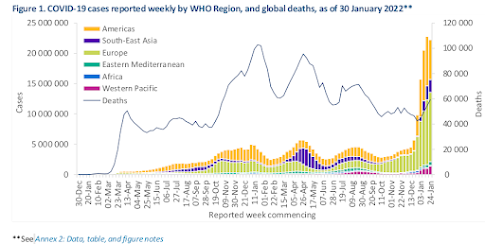#16,543
The latest WHO weekly COVID Epi report (#77) finds the sharp rise in global COVID cases - which began roughly 2 months ago with the emergence of the Omicron variant - continues to generate record numbers of new cases (22 million), on par of what we've seen reported the past couple of weeks.
Hospitalizations, and deaths - while elevated - have not risen nearly as sharply, apparently due to a reduction in Omicron's severity and the protective impact of vaccines around the world.
While a fortuitous turn of events, Omicron is far from benign, particularly among the unvaccinated. And this week the WHO reports a 9% increase in COVID deaths globally.
COVID deaths are a lagging indicator - often coming weeks after a rise in infections - and are generally under-reported as well. The official total of 5.6 million deaths from COVID worldwide is likely a significant undercount.
The WHO summary reads:
Overview
Globally, during the week of 24 to 30 January 2022, the number of new COVID-19 cases remained similar to that reported during the previous week, while the number of new deaths increased by 9%. Across the six WHO regions, over 22 million new cases and over 59 000 new deaths were reported. As of 30 January 2022, over 370 million confirmed cases and over 5.6 million deaths have been reported globally.
At the Regional level, increases in the number of new cases were reported by the Western Pacific (37%) the Eastern Mediterranean (24%) and the European (7%) regions, while a decrease was reported by the Region of the Americas (20%) and the South-East Asia Region (8%). The number of new cases reported in the African Region remained similar to the previous week. The number of new weekly deaths continued to increase in the South-East Asia Region (41%), the Eastern Mediterranean Region (32%) and the Region of the Americas (16%), while the African Region reported a decrease of 7%. The incidence of deaths remained similar to the previous week in the European and the Western Pacific regions.
We are just now beginning to see the impact of Omicron in parts of Asia, with South Korea reporting a tripling of daily cases over the past 2 weeks, today exceeding 20K for the first time. The impact on hospitals, and deaths, from these increases may not become apparent for several more weeks.
Meanwhile, even as Omicron BA.1 rates begin to wane in some parts of the world, a new contender - Omicron BA.2 - appears to pose an even higher transmission threat (see UKHSA: Risk Assessment On Omicron BA.2 Subvariant).
Thus far, we've no evidence to suggest that BA.2 is any more severe than BA.1, but data is limited and studies are ongoing. In the meantime, the WHO has this to say about this new viral threat.
The Omicron variant
Since the designation of B.1.1.529 as a VOC on 26 November 2021, several Omicron lineages have been identified. These include Pango lineages BA.1, BA.1.1, BA.2 and BA.3, which are all being monitored by WHO under the umbrella of ‘Omicron’. The common origin of these lineages has not yet been elucidated and it is not clear to date how and where the Omicron parental variant or the descendent lineages originated and further evolved.
The Omicron variant-defining constellation of mutations fully overlaps with Pango lineage BA.1 (including lineage BA.1.1) , and this accounts for 96.4% of sequences submitted to GISAID as of 31 January 2022. Most evidence we have to date about Omicron is therefore based on this Pango lineage.A relative increase in the BA.2 variant, which differs from BA.1 in some of the mutations, including in the spike protein, has been observed in multiple countries. BA.2- designated sequences have been submitted to GISAID from 57 countries to date, with the weekly proportion of BA.2 relative to other Omicron sequences rising to over 50% during the last six weeks in several countries.
Investigations into the characteristics of BA.2, including transmissibility, immune escape properties and virulence, should be prioritized independently (and comparatively) to BA.1 (WHO Tracking SARS-CoV-2 variants website). It is important to consider the relative proportions of BA.1 and BA.2 sequences in the context of the case incidence when interpreting the data.
WHO continues to monitor circulating and emerging variants and to identify and address relevant knowledge gaps through the development of coordinated, multi-layered surveillance, preparedness, and response strategies for addressing COVID-19.
Although the popular narrative right now seems to be that Omicron is `mild', and that its spread likely signals the `beginning of the end' of the pandemic, we've been here before only to be dissapointed. The truth is, as much as we may want these things to be true, the virus may have other plans.
Omicron (BA.1 or BA.2) may give way to other emerging variants in the months to come, and there are no guarantees they will be as `mild' - at least compared to Delta - as Omicron.
China, which has successfully maintained a `Zero-COVID' policy for nearly 2 years, is another unknown factor. If Omicron, or some other variant, breaches their COVID defenses, the virus will have access to more than 1 billion - mostly immunologically naive - hosts.
While we can hope the worst has passed, COVID's impact is likely far from over.

